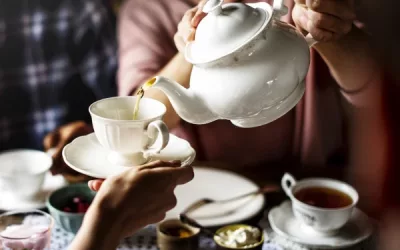If you’re passionate about afternoon tea, you know that crafting the perfect menu is an art. In this article, I’ll share recipes, tips, and tricks to help you create an unforgettable tea experience. Whether you’re hosting a casual get-together or a more formal event, you’ll find everything you need to make your tea time truly special. Ready to elevate your afternoon tea? Let’s dive in!
Table of Content
- What are the essential components of a traditional afternoon tea menu?
- How can you customise an afternoon tea menu to suit different dietary needs?
- What are some creative savoury options for an afternoon tea menu?
- How can you balance sweet and savoury flavours in an afternoon tea menu?
- What are the best presentation tips for an afternoon tea menu?
- How can tiered stands enhance presentation?
- What are some creative ways to use decorative linens?
- How can garnishes be used to improve presentation?
- How can you incorporate seasonal ingredients into an afternoon tea menu?
- What are some examples of seasonal fruits for spring?
- How can seasonal vegetables be used in savoury dishes?
- What are some ways to use seasonal herbs and flowers?
- What practical tips can help in hosting a successful afternoon tea party?
- How can you create a memorable afternoon tea experience for your guests?
- Conclusion
A traditional afternoon tea menu consists of several classic elements which together create an elegant and enjoyable experience. These components include finger sandwiches, scones, pastries, and teas. Each element has its own specific attributes and variations, adding to the overall harmony of flavours and textures. The presentation also plays a key role in setting the mood and making the event special.
Having attended and hosted several afternoon tea events, I find that the beauty of this tradition lies in its sophistication and simplicity. It is the balance of delicate sandwiches, warm scones, indulgent pastries, and a selection of fine teas that make it so appealing.
What types of finger sandwiches are typically included?
Finger sandwiches are an essential component of any afternoon tea menu. They are usually small, crust-less, and made with a variety of fillings. The simplicity and elegance of these sandwiches make them a favourite.
- Cucumber Sandwiches: Often spread with cream cheese or a light butter, these are cool and refreshing.
- Smoked Salmon and Cream Cheese: Typically garnished with a hint of dill or lemon.
- Egg and Cress: A classic choice with finely chopped eggs mixed with mayonnaise and small cress leaves.
- Ham and Mustard: Thinly sliced ham paired with a delicate spread of mustard.
- Chicken and Tarragon: Shredded chicken combined with a hint of tarragon for that extra flavour.
These sandwiches are usually made with white or wholemeal bread and are cut into neat, crust-less rectangles or triangles, making them easy to pick up and eat in a few bites.
How are scones traditionally served?
Scones are a highlight of the afternoon tea menu. They are slightly crispy on the outside, soft and fluffy on the inside, and traditionally served warm.
- Plain Scones: The simplest form, often split in half.
- Fruit Scones: Commonly include currants or sultanas for added sweetness.
- Clotted Cream: This thick cream has a rich texture and is essential for spreading on top of the scone.
- Strawberry Jam: The classic companion to clotted cream, providing a sweet and tangy contrast.
- Butter: Sometimes offered as an additional option for those who prefer it.
Scones are typically presented on a tiered cake stand, with separate small bowls for clotted cream and jam. The traditional way to enjoy them involves spreading a generous amount of jam, followed by a dollop of clotted cream, though the order can vary based on personal preference.
What are some popular pastries for afternoon tea?
Pastries add a touch of indulgence to the afternoon tea menu. They provide a sweet and often artistic ending to the meal.
- Macarons: These delicate French cookies come in a variety of flavours and colours.
- Madeleines: Soft, shell-shaped sponge cakes usually flavoured with lemon or almond.
- Mini Eclairs: Choux pastry filled with cream and topped with chocolate glaze.
- Tarts: Small, individual-sized tarts filled with fruits, custards, or chocolate.
- Victoria Sponge Slices: Layers of light sponge cake with cream and jam in between.
The key to a great pastry selection is variety. This offers different textures and flavours, providing guests with a delightful assortment to choose from.
Back in the 1840s, Anna, the Duchess of Bedford, is credited with inventing afternoon tea. She experienced a “sinking feeling” around 4 p.m. and requested some snacks and tea to be brought to her room. Gradually, she began inviting friends to join her, and this practice evolved into a social event. What started as a private snack became an institution when Queen Victoria herself adopted the tradition, making it a fashionable social ritual.
Once, when I was hosting an afternoon tea for a few friends, I decided to follow a traditional format. I spent the morning preparing cucumber sandwiches, baking scones, and arranging a selection of my favourite pastries.
When my friends arrived, the look of excitement and delight on their faces made all the effort worthwhile. We gathered around the table, chatting, sipping tea, and enjoying the carefully curated treats. It was a fantastic experience that brought everyone together and created lasting memories.
Customising an afternoon tea menu to accommodate different dietary requirements can be tricky but totally doable. It boils down to understanding the specific needs and using appropriate substitutes without compromising on taste or variety.
Below is a table that lays out various dietary requirements, suggested substitutions, and example menu items. This way, you can have a comprehensive approach to meeting everyone’s needs.
The table is designed to be user-friendly. Each row represents a specific dietary requirement, followed by suggested ingredient substitutions, and then a few example menu items that fit the bill.
Use this table to mix and match different items to suit your guests’ preferences.
| Dietary Requirement | Suggested Substitutions | Example Menu Items |
|---|---|---|
| Gluten-Free | Almond flour, coconut flour, GF oats | GF scones, almond flour cookies, cucumber sandwiches with GF bread |
| Vegan | Almond milk, flaxseed eggs, coconut cream | Vegan cucumber sandwiches, almond milk tea, coconut cream scones |
| Dairy-Free | Almond milk, coconut yogurt | Dairy-free scones, almond milk tea, DF sandwich spreads |
| Nut-Free | Sunflower seeds, soy milk | Nut-free cakes, soy milk tea, nut-free sandwiches |
| Sugar-Free | Stevia, monk fruit, erythritol | Sugar-free biscuits, scones with stevia, unsweetened tea |
| Low Carb/Keto | Almond flour, coconut flour, erythritol | Keto scones, cucumber sandwiches with coconut flour bread |
| Paleo | Coconut flour, honey, almond milk | Paleo scones, honey-sweetened tea, sandwiches with coconut flour bread |
| Vegetarian | Plant-based proteins, almond milk | Vegetarian sandwiches, almond milk tea, plant-based scones |
Gluten-Free Options
It’s relatively straightforward to modify traditional afternoon tea items to be gluten-free. Here’s how you can nail it:
- Gluten-free scones: Use almond or coconut flour instead of regular wheat flour.
- GF sandwiches: Source or bake bread made from gluten-free flours like rice or quinoa.
- Almond flour cookies: These are a favourite and super simple to make.
You’ll find that many stores now offer a wide range of gluten-free products, so replacing these items doesn’t mean losing any of the fun or tradition.
Vegan Delights
Ensuring your vegan friends feel included is just as easy. The key is using plant-based alternatives that taste just as delightful:
- Vegan sandwiches: Use spreads like hummus and fill with veggies.
- Almond milk tea: Replace dairy milk with almond or oat milk.
- Coconut cream scones: Create a scrumptious coconut cream topping instead of clotted cream.
Not only are these options kinder to the planet, but they’re also delicious. Whether you choose almond milk, oat milk, or even soy milk, you’ve got loads of choices.

When it comes to selecting creative savoury options for an afternoon tea menu, the possibilities are as endless as they are delectable. We’re not talking about your nan’s plain cucumber sandwiches here. Oh no. We’re diving into the realm of savoury tarts, quiches, finger sandwiches, savoury scones, and dips that’ll make your taste buds sing “Hallelujah!”
So, whether you’re plotting a posh soirée or just want to impress with more than just pastries, here’s a run-down on how to elevate your afternoon tea with savoury delights.
What are some unique savoury tart recipes?
Ah, savoury tarts. The unsung heroes of the afternoon tea menu. They’re versatile, you can dress them up with all sorts of ingredients, and they look fancy on the table. It’s like having Gordon Ramsay in the kitchen but without the swearing.
- Caramelised Onion and Goat’s Cheese Tart: This is where sweet meets tangy. The caramelised onions bring a rich sweetness, balanced perfectly by the creamy, slightly tart goat’s cheese.
- Tomato and Basil Tart: Imagine the classic caprese salad, but in tart form. Ripe tomatoes, fresh basil, and a drizzle of balsamic reduction. Bellissimo!
- Mushroom and Truffle Oil Tart: Earthy mushrooms laced with aromatic truffle oil, this one’s a sure-fire way to bring a hint of luxury.
- Smoked Salmon and Dill Tart: Because, let’s face it, smoked salmon makes anything feel nicer, especially when paired with a zesty dill sauce.
- Leek and Gruyère Tart: Think of it as the more sophisticated cousin of the onion tart. Leek brings mild onion flavour, while Gruyère adds that nutty, creamy goodness.
You slap these tarts on your table, and suddenly your afternoon tea feels like a Michelin-starred affair. Trust me, your guests will devour them faster than you can say “pastry chef.”
How can quiches be incorporated into an afternoon tea?
Say it with me, folks: quiches aren’t just for breakfast. These versatile beauties can shine at any time of day, especially during an afternoon tea event. Think of them as the well-dressed, punctual guest that everyone loves.
- Mini Quiches: Perfectly portioned, these can be made in small muffin tins, letting your guests enjoy without committing to a full slice.
- Vegetarian Quiches: Opt for fillings like spinach and feta or asparagus and ricotta to cater to all your veggie-loving mates.
- Crustless Quiches: For those counting calories but still wanting to indulge, go crustless! You still get all the flavour but with a little less guilt.
- Lorraine Quiche: The classic—ham, cheese, onions. An absolute crowd-pleaser with its rich flavours and creamy texture.
- Seafood Quiche: Add some luxury with ingredients like crab meat and prawns, paired with a light lemon zest for a refreshing twist.
You can also pre-make these quiches and serve them cold or at room temperature, meaning less hassle on the day. Pop a few different flavours on your table, and it’ll look like you’ve gone the extra culinary mile without even breaking a sweat.
What are some innovative finger sandwich fillings?
Finger sandwiches are the quintessential element of an afternoon tea menu, but who says they have to be boring? Wave goodbye to the monotonous and say hello to these innovative fillings that’ll make your taste buds do a happy dance.
- Curried Chicken and Mango Chutney: A bit of spice, a bit of sweet. This combo is a flavour parade.
- Beetroot, Walnut, and Goat Cheese: Earthy beetroot meets creamy goat cheese and crunchy walnuts. A mouthful of textures.
- Smoked Salmon and Wasabi Cream Cheese: Classic salmon gets a kick with a hint of wasabi. Just enough to wake up the palate.
- Cucumber, Mint, and Hummus: A refreshing twist on the classic. The mint leaves refresh while the hummus adds a nutty richness.
- Roast Beef and Horseradish: A hearty option. Thin slices of roast beef paired with a sharp, tangy horseradish sauce make this sandwich unforgettable.
These fillings bring boldness and flair to your finger sandwiches, ensuring they steal the spotlight on your tea table. Arrange them geometrically or cut them into fun shapes to add a bit of whimsy to your display. And there you have it, finger sandwiches gone gourmet.
Once upon a time, the Duchess of Bedford introduced afternoon tea as a mini-meal to curb hunger between lunch and dinner. She realised that no one could focus on anything with a rumbling belly, and soon all of London followed her lead. Fast forward to today, with the help of these savoury options, you can host an event so grand, the Duchess herself would queue for a seat at your table.
Striking the right balance of sweet and savoury in your afternoon tea menu is an art form. It’s all about keeping your guests’ taste buds entertained without overwhelming them. You want to avoid sugar overload while ensuring the savoury bites don’t steal the show. Here’s how you can master this balancing act.
First, let’s dive into flavour pairing. Think of this as arranging a harmonious dance between different tastes. Once you’ve got pairing down, menu planning becomes a cinch. Pay attention to portion sizes – not too big, not too small, try to channel your inner Goldilocks to get it just right.
Alternating courses is another great way to keep things interesting. And let’s not forget pallet cleansers – these unsung heroes will keep your guests refreshed and ready for more delightful bites.
What are some effective flavour pairings for afternoon tea?
When it comes to pairing, opposites often attract. Think of it as matchmaking for snacks. Consider combining these:
- Cucumber sandwiches with lemon posset: The refreshing taste of cucumber balances the tart sweetness of the lemon.
- Egg mayo on crusty bread with scones and clotted cream: The creamy, savoury filling of the egg pairs well with the rich sweetness of scones.
- Smoked salmon and dill with chocolate eclairs: The salty, smoky flavour of the salmon is offset perfectly by the rich, creamy eclairs.
- Cheddar cheese scones with strawberry jam: The tangy sharpness of cheddar pairs wonderfully with the sweet and slightly tart flavour of strawberries.
- Herb goat cheese tartlets with honey-drizzled figs: The earthy flavours of herbs and goat cheese are complemented by the sweet, succulent figs.
Now, doesn’t that sound like a party for your taste buds? By mixing these different flavours, each bite becomes an adventure.
Menu planning is like conducting an orchestra – each component should contribute to a harmonious whole. Here’s your cheat sheet:
- Start with savoury: Pace your guests. Begin with savoury options like finger sandwiches and cheese scones.
- Alternate sweet and savoury: After a few savoury items, introduce a sweet one. Alternate to keep the palate awake.
- Consider portion sizes: Go for small, manageable portions. Think mini quiches, petit fours, and two-bite sweets.
- Balance richness: If you have rich, heavy items like a ganache tart, balance them with lighter, more refreshing items like cucumber sandwiches.
- Offer a variety: Ensure a mix of flavours, textures, and colours. A varied plate is always more appealing.
Remember, moderation is key. You want your guests to savour each bite, not waddle home in a sugar coma.
What are some examples of palate cleansers?
Palate cleansers are like the intermission in a theatre production – they keep things fresh:
- Lemon sorbet: A zesty, cool sorbet can cut through heavy flavours.
- Cucumber water: Infuse water with cucumber slices for a crisp, refreshing sip.
- Green apple slices: Tart and juicy, these can refresh the taste buds.
- Ginger tea: Spicy and warm, ginger can reset your palate.
- Mint leaves: Chewing a fresh mint leaf can instantly cleanse the palate.
These little interludes can make a world of difference, keeping the experience light and enjoyable.
The tradition of afternoon tea harks back to the 1840s when the Duchess of Bedford found herself peckish between lunch and dinner. This simple craving led to a delightful habit that would sweep across the upper echelons of British society. Imagine hosting your own tea and echoing the sumptuous spreads favoured by the aristocrats of yore.
The Duchess’ concept was genius – offering a range of light treats and refreshing teas to whet the appetite while ensuring no one left hungry before dinner. It’s a tradition that has evolved yet continues to inspire hosts and hostesses around the world, including you. Cheers to creating your own modern-day twist on this timeless tradition!
When planning an afternoon tea, the difference between a ho-hum gathering and an Insta-worthy event often boils down to presentation. You’ve got your finger sandwiches, scones, and petit fours ready but how they’re presented will determine whether your guests reach for their phones or just for another cup of tea. Let’s dive into the nitty-gritty of what makes an afternoon tea not just delicious but also visually stunning.
How can tiered stands enhance presentation?
Imagine walking into a room and spotting those delightful tiered stands brimming with goodies. It’s like saying, “Welcome to the fanciest garden party ever.” Now, tiered stands aren’t just for showing off; they serve a functional purpose too. Small details make a big difference. Let’s break it down.
- Space-saving: These stands maximise your table space, leaving you room for other essentials like flowers or that ginormous teapot.
- Visual hierarchy: They create a pleasing visual journey, leading the eye from savoury to sweet delights.
- Ease of access: Your guests can pick their preferred treats without playing ‘pass the plate’—a particular blessing for the socially awkward.
- Versatility: You can mix and match different tiers with varying treats—mini quiches chilling next to macaroons? Why not!
- Elegance boost: Simply put, they look classy. Grandma’s silver stand or a sleek modern design can instantly elevate the atmosphere.
So, if you want your tea party to scream sophistication, tiered stands are your BFFs.
What are some creative ways to use decorative linens?
Fam, don’t underestimate the power of a good tablecloth or napkin. They’re the unsung heroes of table décor. Think of linens as the foundation upon which the entire tea experience is built. How you accessorise your table sets the tone for your event.
- Pattern play: Floral or lace tablecloths for a traditional vibe or bold prints for a modern twist—your choice sets the mood.
- Colour coordination: Match linens with your dishware and flowers to tie everything together. It’s like colour blocking but for your table.
- Accents: Add runners or place mats for layers. It’s like the haute couture of table settings.
- Themed décor: Seasonal or themed linens (Christmas holly, Easter bunnies) can make your event feel extra special.
- Folds and ties: Napkin folding is an art form. Origami swans or simple fans, these little touches can impress without much effort.
Using linens creatively can make the difference between ‘oh, a table’ and ‘oh wow, a masterpiece.’
How can garnishes be used to improve presentation?
Garnishes might seem like the supporting cast, but sometimes they steal the show. They add that little je ne sais quoi that elevates your treats from ‘yummy’ to ‘legit gourmet’.
- Edible flowers: Nasturtiums, violets, and pansies not only look beautiful but are a great conversation starter. “Is this flower safe to eat?” Yes, Karen, it is.
- Herb sprigs: Mint, basil, and rosemary aren’t just for cocktails. They can make a simple sandwich look like a chef’s creation.
- Fruit slices: Lemon twists on scones or strawberry slices on pastries add colour and freshness.
- Dusting of sugar: Confectioner’s sugar or cocoa powder dusted over desserts can turn them into works of art.
- Zests and curls: Citrus zests or chocolate curls provide flair and make your guests feel like you took that extra step—because you did.
Garnishes are your chance to put a personal touch on your menu, making everything look Pinterest-perfect.
In the 1800s, Anna, the Duchess of Bedford, probably had no idea that her simple tea-and-snacks solution would evolve into today’s stylish afternoon activities. Imagine our pal Anna calling her maid for ‘little cakes’ to stave off hunger pangs until dinner. She must’ve been thrilled when her friends started joining her, and voila, afternoon tea was born. Back then, presentation was all about chinaware and the quality of tea. Now, it’s an art form. So, channel your inner Duchess Anna, and make those tiered stands, linens, and garnishes count!
Alright, butter your crumpets and hold onto your teapots, because we’re diving into the art of pimping up your afternoon tea menu using the freshest, most in-season ingredients. Whether you’re a wannabe Mary Berry or just someone who loves having friends over for a chinwag and a cuppa, using seasonal ingredients can take your afternoon tea from “meh” to marvellous. It’s not just about showcasing what’s fresh and fabulous; it’s also about creating a spread that screams, “I’ve got this.”
What are some examples of seasonal fruits for spring?
Spring’s like nature’s way of saying “let’s party!” The fruit selection is a headliner, boasting varieties that’ll make your scones sing and your tarts tantalise.
- Strawberries: Traditional and ever-so British. Slap them on a scone with some clotted cream and you’re golden.
- Rhubarb: Perfect for a tangy twist in your pies or jams.
- Apricots: Wonderful for tarts or as a fresh slice on top of your cakes.
- Cherries: Think compotes, think cakes, think divine.
- Honeydew Melon: Ideal for fruit salads or even as a refreshing garnish.
Spring fruits aren’t just a pretty addition—they bring vibrant colours, delightful flavours, and the kind of freshness that’ll make your guests wonder if you secretly own a fruit farm.
How can seasonal vegetables be used in savoury dishes?
Let’s not forget about the unsung heroes of the garden patch. Seasonal veggies can put the “oomph” in your savoury tea-time treats, making them as interesting as your niece’s relationship drama (and that’s saying something).
- Asparagus: Fabulous in mini quiches or as a finger-friendly asparagus roll wrapped in prosciutto.
- Peas: Ideal for pea and mint crostinis or pea-stuffed vol-au-vents. Sweet, crunchy, and quintessentially spring.
- Radishes: Great for colour and crunch in your sandwiches or sliced thinly on open-faced bites.
- Spring Onions: Perfect for adding a zing to your savoury scones or mixed in cream cheese for a spread.
- Spinach: Spinach and cheese savoury muffins? Yes, please. Or how about rolled into phyllo pastry for a modern spanakopita twist.
Vegetables aren’t just rabbit food—they’re here to jazz up your savouries and make your guests believe you’ve got Gordon Ramsay locked in the pantry.
What are some ways to use seasonal herbs and flowers?
Herbs and flowers. No, we’re not assembling a bouquet—though, admittedly, it would smell amazing. These little wonders can elevate your dishes both in flavour and presentation. Let’s sprinkle some fairy dust on your menu.
- Mint: Fresh and sprightly, great in teas, mocktails, or as a garnish for desserts.
- Basil: Pesto bites, caprese sandwiches, or infused in delicate cakes—the versatility is incredible.
- Rosemary: Super in shortbread or as a savoury kick in your cream cheese spreads.
- Edible flowers: Nasturtiums add peppery flavour, violets for delicate sweetness, and marigolds for a slight citrus touch.
- Lavender: Stunning in cookies, scones, or infused syrups for a chic twist.
Herbs and flowers add that touch of whimsy to your menu. They bring a certain je ne sais quoi that’ll make your soiree the stuff of legend.
On that note, let’s whisk you back to the 19th century. Queen Victoria’s courts often held elaborate afternoon teas. One legend goes that the Queen herself adored her simple scones topped with the freshly made jam of the season. These royal teas were so influential that they essentially turned the modest afternoon tea menu into a social spectacle. So, when you’re serving up your carefully crafted spread, just imagine the glittering courts of Victoria and know you’re part of a delicious tradition.
Now, go forth and plan an afternoon tea that would make even Her Majesty proud. The kettle’s on and it’s high-time to get seasonal.
What practical tips can help in hosting a successful afternoon tea party?
Throwing a spectacular afternoon tea party can seem as daunting as a Great British Bake Off challenge. But worry not, my fellow party host! Armed with some practical tips, you’ll be popping those cucumber sandwiches and scones like a pro.
- Plan ahead: Think like a seasoned chess player. Getting your ducks in a row well before the party date can save a lot of headache later.
- Prepare in advance: Channel your inner Boy Scout – “Be Prepared”. This means doing as much as you can before the day arrives.
- Set the scene: Transform your space into a setting fit for Downton Abbey. The right decor and atmosphere can elevate an average gathering to an unforgettable bash.
- Guest interaction: Make sure your guests are as happy as kids in a candy store. Interaction here is key.
- Clean-up strategies: Who wants to end a fabulous event with a headache-inducing clean up? Not you, mate.
So, let’s dive into the nitty-gritty with the following points to ensure your afternoon tea menu sparkles like the Queen’s jewels.
How far in advance should you start planning?
Right, so let’s tackle the million-dollar question: when to start planning? The simple answer is as soon as you can.
Think of planning as marinating a steak; the longer you do it, the better the outcome.
- Booking: Start by locking in the date and sending out invitations at least three weeks in advance. It gives your busy bees enough time to clear their schedules.
- Menu: Once the date’s set, begin drafting your afternoon tea menu. Decide on the type of tea and food you’ll serve—sandwiches, cakes, pastries, you name it.
- Decorations: Plan your decor a couple of weeks ahead. You may want to theme the party, and themes need time to execute properly.
- Entertainment: Don’t forget about games or any tea-related trivia. Make your guests feel like they’re part of the event, not just spectators.
Starting early means you’re less likely to forget things. Because trust me, running around frantic like a headless chicken is no fun.
What are some tips for preparing in advance?
Now let’s move to the heavy lifting (not literally, don’t panic).
Preparation is your secret weapon here.
- Shopping: Do your grocery run at least two days before. Fresh ingredients make all the difference, especially for those pesky clotted creams and finger sandwiches.
- Cooking: Get into Gordon Ramsay mode a day prior to the event. Bake your cakes and pastries ahead of time – they often taste better after sitting for a day anyway.
- Setting the Table: Lay out your place settings the night before. It’s amazing how much time and stress this little step can save you on the day.
- Organise: Have a checklist. This is your Bible. Tick off items as they’re done to avoid those “Oh shoot!” moments.
- Emergency Kit: Keep a little box of essentials handy – plasters, aspirin, extra napkins, etc. Trust me, you’ll thank me later.
Advance preparation means you’ll be as cool as cucumber sandwiches when the first guest knocks.
How can you set the scene for a memorable event?
Image matters. Make your living room transform into a posh tea room, and your guests will swoon.
- Theme: Choose a theme, whether it’s a traditional English tea, a 1920s jazz age, or even Alice in Wonderland. Consistent themes make the decor both easier and more impactful.
- Tables: Forget paper plates. Use real china and nice linens. Even if you borrow them, they add an aura of sophistication.
- Flowers: Fresh flowers on the table can work wonders. Roses, tulips, or even simple daisies can be a perfect touch.
- Lighting: Make sure the lighting is soft but ample. Candles or fairy lights bring a magical vibe.
- Background Music: Have a playlist ready. Classical, jazz, or some light modern tunes can add to the ambiance. Silence is awkward, and you don’t want it feeling like a library.
Setting the scene ensures your tea party will be talked about—and envied—for months to come.
How can you create a memorable afternoon tea experience for your guests?
Creating a memorable afternoon tea experience is all about blending tradition with a sprinkle of creativity. You’ve got the basics down—sandwiches, scones, and a good brew—but let’s take it up a notch. Bringing in some unique elements like personal touches, interactive activities, themed decor, a little mood-setting music, and thoughtful guest favours will elevate your tea party from fine to fabulous.
Now, before you start thinking that this sounds like a lot of work, it’s easier than it looks. And, trust me, your guests will talk about your tea party for months. So, let’s dive in and sprinkle some magic on that classic afternoon tea menu of yours.
What personal touches can make the event special?
Personal touches are like the cherry on top of your perfectly baked Victoria sponge. They make your guests feel valued and appreciated.
- Custom Name Tags: Have personalized name tags or seating cards. It’s like saying, “Hey, I thought about you!”
- Handwritten Menu Cards: List the afternoon tea menu on handwritten cards for a homey touch.
- Family Heirlooms: Use your grandma’s vintage tea set. Stories behind each chipped cup can spark conversations.
- Photo Memories: Display photos featuring you and your guests from past get-togethers.
- Custom Tea Blends: Offer bespoke tea blends tailored to your guests’ preferences. Who wouldn’t love a cup of “Sarah’s Strawberry Serenade”?
Including these personal elements shows your guests that this isn’t just any gathering—it’s a curated experience just for them.
How can interactive elements enhance the experience?
Interactive elements turn your guests from mere spectators into active participants, making the event engaging and memorable.
- Tea Tasting Station: Set up a station where guests can mix their tea blends.
- DIY Sandwich Making: Provide ingredients for people to create their ultimate finger sandwich.
- Scone Decorating: Offer clotted cream, jams, fruits, and even edible flowers for a scone-decorating contest.
- Trivia Games: Tea-themed trivia can be a fun icebreaker.
- Photo Booth: Have a Victorian-era photo booth with quirky props—bowler hats and monocles for the win.
These activities make the event feel more alive and allow guests to mingle and connect in unexpected ways.
What are some ideas for themed decor?
Themed decor transforms your space into a wonderland, making your guests feel like they’ve stepped into a different era or place.
- Vintage Garden Party: Think lace tablecloths, floral arrangements in teapots, and fairy lights.
- Alice in Wonderland: Teetering stacks of mismatched teacups, playing card decorations, and “Eat Me” “Drink Me” labels.
- 1920s Gatsby Glitz: Jazz music, feather centrepieces, and lots of gold and black.
- Royal British: Union Jack bunting, golden cutlery, and an air of regal sophistication.
- Seasonal Magic: Autumn leaves and pumpkins for fall, pastel blooms for spring, snowflakes and twinkling lights for winter tea.
The right decor can transport your guests and sets the mood for the entire event.
Sometimes, we think traditions are set in stone. But did you know that afternoon tea, that oh-so-British institution, isn’t as old as you might think? Anna, the Duchess of Bedford, is credited with inventing afternoon tea in the 1840s. She needed a little pick-me-up between lunch and dinner—who wouldn’t? So, she started inviting friends over for an afternoon snack of tea, bread, butter, and sweets.
It became so popular that Queen Victoria herself caught on, and thus, a tradition was born. Your tea party doesn’t need to stick to the old script. Mix in a bit of yourself, a dash of interaction, and a smidgen of decor magic, and you’ll create moments your guests will cherish just as much.
Conclusion
Reflecting on the journey of crafting the perfect afternoon tea menu, I’ve come to appreciate the blend of tradition and innovation that characterises this beloved British pastime. Each component, from delicate finger sandwiches to sumptuous scones, plays a crucial role in creating an inviting and memorable experience.
Customising the menu to suit various dietary needs not only demonstrates thoughtfulness but also ensures that everyone can partake in the joys of afternoon tea. The incorporation of seasonal ingredients and creative savoury options adds another layer of excitement and flavour that can set your gathering apart.
Understanding how to balance sweet and savoury flavours, alongside the art of presentation, is instrumental in turning a simple tea party into an extraordinary event. I’ve realised that it’s often the small details—like selecting the right decorative linens or offering palate cleansers—that leave a lasting impression on guests. In a world where culinary experiences are shared and celebrated, the ability to host an afternoon tea party with flair and thoughtfulness stands out.
As I consider the broader implications of these insights, I am struck by how much an afternoon tea gathering can foster connection and joy among friends and family. It isn’t just about the food; it’s about creating a tapestry of shared moments, laughter, and conversation that can resonate long after the event has concluded.
So, as you plan your own afternoon tea, I invite you to embrace the opportunity to personalise the experience to your tastes and those of your guests. What unique flavours or themes might you incorporate? Ultimately, it’s the personal touches and thought behind each detail that transform a simple gathering into an unforgettable affair.
I leave you with this quote by Willa Cather: “There are only two or three human stories, and they go on repeating themselves as fiercely as though they had never happened before.” Your afternoon tea menu is another of those stories waiting to be told.







